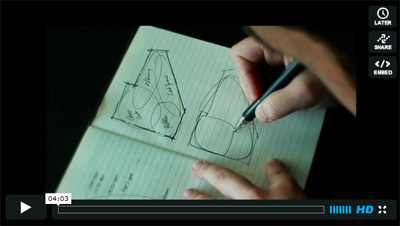
Aug '05 - Jan '11
Since my last entry, a lot has changed. I moved on from Fuksas in Rome and I'm back in Columbus, Ohio. I am now working at NBBJ and have taught a few parametric modeling seminars at Knowlton.
I would like to share with you some of the research I have been doing at NBBJ for conceptual design tools. All of the work is done in Rhino with the Grasshopper and Kangaroo plug-ins.
----
Architecture: Realtime Physics for Space Planning
http://vimeo.com/15563685
I wanted to develop a system that allows designers to quickly organize and understand complex architectural programmes in three dimensions.
It is an advancement of the traditional bubble diagram; it solves adjacency requirements automatically and suggests planimetric and sectional relationships. The resulting diagrams are not formal solutions; they are simply organizational diagrams with solved adjacencies and accurate required areas. The diagrams are raw materials, meant to be manipulated sculpturally, or even squeezed into a formal container.



2 Comments
marc,
this looks really awesome, though i do have a few questions... how would you incorporate IDP elements into the planning? how would you incorporate issues of daylighting, ventilation, etc? how do you keep the anchor points from being arbitrary?
basically, i'm looking at this and thinking how you/NBBJ would keep from doing boxy things instead of narrower floor plates like at the bill & melinda gates foundation.
also - music?
great job.
holz.box> thanks for watching...
To answer your questions hopefully without being too vague:
Daylighting and ventilation are interesting questions, though they don't find a place specifically within this tool. However, the anchor objects can just as easily be used to drive daylighting or ventilation concerns as they can be used to refer to site conditions. For instance, you could use anchor objects to constrain a particular program element to the southern edge of a site for daylight exposure. However, if your intent is to optimize ventilation through the use of the stack effect, for instance, this is not the tool to tell you how to do it. Rather, you would have that goal in mind while you construct the adjacency relationships, anchor objects, and site relationships.
You keep the anchor objects from being arbitrary by using them for specific ends -- whether that is to tie a program to a very specific geospatial location or simply to affect the disposition of the entire composition with a certain goal in mind. You may know certain program elements need to be disposed more or less in a certain way, and you may use anchor objects to achieve that, while also allowing the less critical elements to fall in line according to their adjacency requirements. While this probably sounds a bit vague, all I can say is that intent is the cure for arbitrariness.
I tried to show in the last few seconds that once the simulation has reached equilibrium, it should be treated as a malleable object. So there is no reason that the results should boxy or narrow or curvy or anything else in particular. The raw materials are there as a suggestive diagram for adjacencies and GBA, and they are independent of the formal solution.
I should have credited the music:
Phoenix, "Love Like a Sunset", from their album Wolfgang Amadeus Phoenix
Block this user
Are you sure you want to block this user and hide all related comments throughout the site?
Archinect
This is your first comment on Archinect. Your comment will be visible once approved.